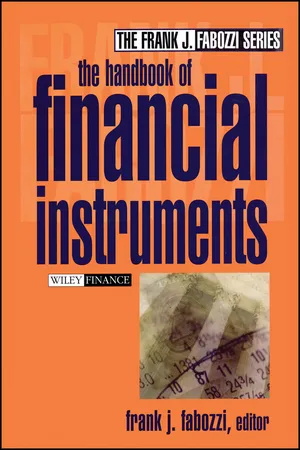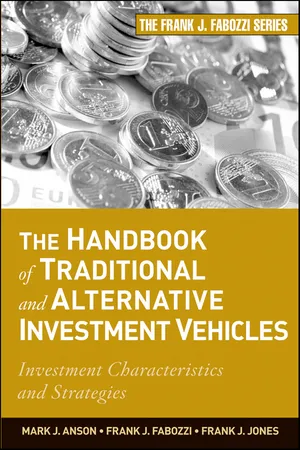Economics
US Government Securities
US Government Securities are debt instruments issued by the US Department of the Treasury to finance government operations and manage the national debt. They are considered low-risk investments and include Treasury bills, notes, and bonds. These securities are widely traded and are often used as a benchmark for other interest rates in financial markets.
Written by Perlego with AI-assistance
Related key terms
Related key terms
1 of 4
Related key terms
1 of 3
5 Key excerpts on "US Government Securities"
- eBook - ePub
- Frank J. Fabozzi, Frank J. Fabozzi(Authors)
- 2018(Publication Date)
- Wiley(Publisher)
Chapter 7 U.S. Treasury SecuritiesFrank J. Fabozzi, Ph.D., CFAAdjunct Professor of Finance School of Management Yale University Michael J. Fleming, Ph.D.* Senior Economist Federal Reserve Bank of New YorkUnited States Treasury securities are direct obligations of the U.S. government issued by the Department of the Treasury. They are backed by the full faith and credit of the U.S. government and are therefore considered to be free of credit risk. Issuance to pay off maturing debt and raise needed cash has created a stock of marketable Treasuries that totaled $2.8 trillion on June 30, 2001.1 Treasuries trade in a highly liquid round-the-clock secondary market with high levels of trading activity and narrow bid-ask spreads. Despite the absence of credit risk and the high level of liquidity, an investor in a Treasury security is still subject to interest rate risk and non-U.S. investors who seek to convert payments from U.S. dollars to their local currency are exposed to currency risk. As will be explained, there are Treasury securities that are available that eliminate inflation risk and reinvestment risk.Treasury securities serve several important purposes in financial markets. Due to their liquidity and well-developed derivatives markets, Treasuries are used extensively to price, as well as hedge positions in, other fixed-income securities. Exemption of interest income from state and local taxes also helps make Treasuries a popular investment asset to institutions and individuals. Moreover, by virtue of their creditworthiness and vast supply, Treasuries are a key reserve asset of central banks and other financial institutions.TYPES OF SECURITIES
Treasuries are issued as either discount or coupon securities. Discount securities pay a fixed amount at maturity, called face value or par value, with no intervening interest payments. Discount securities are so called because they are issued at a price below face value with the return to the investor being the difference between the face value and the issue price. Coupon securities are issued with a stated rate of interest, pay interest every six months, and are redeemed at par value (or principal value) at maturity. Coupon securities are issued at a price close to par value with the return to the investor being primarily the coupon payments received over the security’s life. - eBook - ePub
The Handbook of Traditional and Alternative Investment Vehicles
Investment Characteristics and Strategies
- Mark J. P. Anson, Frank J. Fabozzi, Frank J. Jones(Authors)
- 2010(Publication Date)
- Wiley(Publisher)
CHAPTER 5U.S. Treasury and Federal Agency SecuritiesThe securities issued by the U.S. Department of the Treasury (U.S. Treasury hereafter) are called Treasury securities, Treasuries, or U.S. government securities. Because they are backed by the full faith and credit of the U.S. government, market participants throughout the world view them as having no credit risk. Hence, the interest rates on Treasury securities are the benchmark default-free interest rates.In this chapter, the different types of marketable Treasury securities are explained. In addition, we describe securities issues by federal agencies, entities chartered by Congress to provide funding support for the housing and agricultural sectors of the U.S. economy and specific funding projects of the U.S. government. The largest issuers are also known as government-sponsored enterprises (GSEs). GSEs are either public or government owned shareholder corporations (Fannie Mae, Freddie Mac, and Tennessee Valley Authority) or the funding entities of federally chartered bank lending systems (Federal Home Loan Banks and the Federal Farm Credit Banks). The debt of the GSEs is not guaranteed by the U.S. government.TREASURY SECURITIES
Treasury securities are classified as nonmarketable and marketable securities. The former securities include savings bonds that are sold to individuals and state and local government series (SLGS) securities that are sold to state and local government issuers of tax-exempt securities. There are two types of marketable Treasury securities issued: fixed-principal securities and inflation-indexed securities.Advantages of investing in Treasury securities in addition to their minimal credit risk (assuming the U.S. government action in the future does not alter this perception) is that they are highly liquid and the interest paid is exempt from state and local income taxes.Fixed Principal Treasury Securities: Treasury Bills
The U.S. Treasury issues two types of fixed principal securities: - eBook - ePub
Investing in Fixed Income Securities
Understanding the Bond Market
- Gary Strumeyer(Author)
- 2012(Publication Date)
- Wiley(Publisher)
Chapter 9
U.S. Treasury and Government Agency Securities
Warren ShareU.S. TREASURY SECURITIES
U.S. Treasury securities are the highest-quality debt obligations available. Treasuries are direct government obligations, backed by the full faith and credit of the U.S. government. Proceeds from the sale of these securities are used by the U.S. Treasury to finance the activities of the federal government or to refund outstanding debt. Since Treasuries are generally considered to be free of credit risk, they are used as a benchmark for interest rates in the United States and around the world.Next to credit quality, the most important feature Treasuries offer investors is liquidity. Liquidity is the ease with which a financial asset can be converted to cash without a substantial change in price. U.S. Treasury securities trade in a large and active secondary market, supported by primary dealers and numerous institutional investors around the world. Consequently, the markets to buy and sell Treasuries are generally liquid and transparent. By transparent, I mean that current market quotations are available to investors continuously. Tax benefits are another selling point, as U.S. Treasuries are exempt from state and local taxes (but are subject to federal tax). Keep in mind, however, that for some investors this income may also be subject to the Alternative Minimum Tax (AMT).Treasuries are obviously not entirely free from risk. Despite having little or no credit risk, the value of Treasury securities fluctuates with changes in market interest rates (interest rate risk). The degree of price volatility will depend on many factors including the duration of the bond and the coupon size (see Chapter 2 for discussion of duration and convexity). In addition, some Treasury securities are issued with call options, providing the Treasury with an option to retire the debt prior to its stated maturity. In a volatile interest rate environment, this is a significant risk for investors. Additionally, issues affecting the underlying creditworthiness of Treasuries can surface, however rarely. In early 1996, Moody’s Investors Service threatened a possible downgrade of U.S. Treasuries, due to the failure of the U.S. Congress to raise the debt ceiling during a heated balanced budget negotiation. The gridlock subsided, but the situation provides a reminder that nothing can be taken entirely for granted, even the apparent riskless nature of U.S. Treasuries. - eBook - ePub
The Business of Investment Banking
A Comprehensive Overview
- K. Thomas Liaw(Author)
- 2011(Publication Date)
- Wiley(Publisher)
Table 9.1 shows, the U.S. government did not raise any new cash and paid back it debt in 2000 and 2001. From 2002 to 2007, the government raised cash in the range of $150 billion to $370 billion. The amount of cash raised surged to $1.241 trillion and $1.353 trillion in 2008 and 2009 during the global financial crisis to stimulate the economy.Table 9.1 Issuance of Treasury Securities ($ Billions)At yearend 2010, the U.S. government deficit totaled $14.025 trillion, with marketable securities at $8.863 trillion and nonmarketable securities at $4.634 trillion. Marketable Treasury bills outstanding were $1.772 trillion, Treasury notes outstanding were $5.571 trillion, Treasury bonds outstanding were $0.892 trillion, and Treasury inflation indexed securities were $0.616 trillion. The deficit continued to increase and reached the debt ceiling by August 2011, forcing Congress to consider raising the limit. Those securities are issued through regular auctions.Government Securities
Four types of government securities trade in the securities markets:- Treasury bills are short-term securities with a maturity period of up to one year. Currently, the Treasury Department issues 4-week, 13-week, 26-week, and 52-week bills. These bills are discount instruments; they do not pay coupon interest. Holders of the bills receive the face amount at maturity.
- Treasury notes are medium-term securities that have a maturity of between 2 and 10 years. Currently, the Treasury issues notes with a maturity period of 2, 3, 5, 7, or 10 years. The 10-year note is the current interest rate benchmark.
- Treasury bonds are long-term securities with a maturity period of 30 years. Notes and bonds pay coupons every six months; hence they are also called coupon Treasury securities (or coupon Treasuries).
- Treasury Inflation Protection Securities (TIPS) are inflation-indexed notes and bonds; the interest rate is fixed, but the principal is adjusted for inflation. At maturity, holders will receive the greater of the par amount at original issue or the inflation-adjusted principal.
These securities are sold through regularly scheduled auctions. The auction frequency is summarized in Table 9.2 - eBook - ePub
Understanding Investments
Theories and Strategies
- Nikiforos T. Laopodis(Author)
- 2012(Publication Date)
- Routledge(Publisher)
What would be the implications of an actual downgrading of US debt? A downgrade would spike interest rates on Treasuries, raising the cost of borrowing throughout the economy. That is because Treasuries are considered benchmark rates upon which all other rates in the economy are based. Thus, higher interest rates could harm economic recovery. Second, an actual downgrade would have severe implications for the Chinese economy, because it is the largest holder of US debt abroad. Another consequence of a downgrade of Treasuries, according to some analysts,is that stocks could benefit from such a decline in demand from Treasuries (as bonds would be worth less if rates climbed). Of course, other analysts believe that a downgrade warning would help Treasuries because it would make them more attractive in the long run. Finally, an actual downgrade would also have implications for the risk-free security, the only one of its kind in the world, which might not attract investments from investors worldwide in times of financial turmoil and uncertainty.Sources : US warned on debt load, Wall Street Journal , April 19, 2011; US bond downgrade would help stocks, hurt bonds, Denver Post , April 19, 2011; How S&P’s warning could actually help US debt, Associated Press , April 25, 2011.KEY CONCEPTS
A fixed-income security is one that pays an even specified amount (cash flow) over a predetermined period.A bond is a promissory note (security) that obliges the issuer to make specific payments to its holder during a specified period.The indenture is the contract of the bond.Treasury inflation -protected securities are marketable securities whose principal is adjusted for changes in inflation.Eurobonds are bonds issued in one currency but sold in other markets at that currency. A sovereign bond
Index pages curate the most relevant extracts from our library of academic textbooks. They’ve been created using an in-house natural language model (NLM), each adding context and meaning to key research topics.
Explore more topic indexes
Explore more topic indexes
1 of 6
Explore more topic indexes
1 of 4




